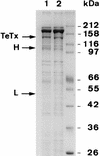TetR is a positive regulator of the tetanus toxin gene in Clostridium tetani and is homologous to botR
- PMID: 9826344
- PMCID: PMC108720
- DOI: 10.1128/IAI.66.12.5698-5702.1998
TetR is a positive regulator of the tetanus toxin gene in Clostridium tetani and is homologous to botR
Abstract
The TetR gene immediately upstream from the tetanus toxin (TeTx) gene was characterized. It encodes a 21,562-Da protein which is related (50 to 65% identity) to the equivalent genes (botR) in Clostridium botulinum. TetR has the feature of a DNA binding protein with a basic pI (9.53). It contains a helix-turn-helix motif and shows 29% identity with other putative regulatory genes in Clostridium, i.e., uviA from C. perfringens and txeR from C. difficile. We report for the first time the transformation of C. tetani by electroporation, which permitted us to investigate the function of tetR. Overexpression of tetR in C. tetani induced an increase in TeTx production and in the level of the corresponding mRNA. This indicates that TetR is a transcriptional activator of the TeTx gene. Overexpression of botR/A (60% identity with TetR at the amino acid level) in C. tetani induced an increase in TeTx production comparable to that for overexpression of tetR. However, botR/C (50% identity with TetR at the amino acid level) was less efficient. This supports that TetR positively regulates the TeTx gene in C. tetani and that a conserved mechanism of regulation of the neurotoxin genes is involved in C. tetani and C. botulinum.
Figures






Similar articles
-
BotR/A and TetR are alternative RNA polymerase sigma factors controlling the expression of the neurotoxin and associated protein genes in Clostridium botulinum type A and Clostridium tetani.Mol Microbiol. 2005 Jan;55(1):235-49. doi: 10.1111/j.1365-2958.2004.04377.x. Mol Microbiol. 2005. PMID: 15612931
-
Regulation of toxin synthesis in Clostridium botulinum and Clostridium tetani.Toxicon. 2013 Dec 1;75:90-100. doi: 10.1016/j.toxicon.2013.06.001. Epub 2013 Jun 13. Toxicon. 2013. PMID: 23769754
-
Tetanus Toxin Synthesis is Under the Control of A Complex Network of Regulatory Genes in Clostridium tetani.Toxins (Basel). 2020 May 15;12(5):328. doi: 10.3390/toxins12050328. Toxins (Basel). 2020. PMID: 32429286 Free PMC article.
-
Regulatory Networks Controlling Neurotoxin Synthesis in Clostridium botulinum and Clostridium tetani.Toxins (Basel). 2022 May 24;14(6):364. doi: 10.3390/toxins14060364. Toxins (Basel). 2022. PMID: 35737025 Free PMC article. Review.
-
Regulation of toxin and bacteriocin synthesis in Clostridium species by a new subgroup of RNA polymerase sigma-factors.Res Microbiol. 2006 Apr;157(3):201-5. doi: 10.1016/j.resmic.2005.11.004. Epub 2005 Dec 29. Res Microbiol. 2006. PMID: 16439101 Review.
Cited by
-
Clostridium difficile toxins: mechanism of action and role in disease.Clin Microbiol Rev. 2005 Apr;18(2):247-63. doi: 10.1128/CMR.18.2.247-263.2005. Clin Microbiol Rev. 2005. PMID: 15831824 Free PMC article. Review.
-
Clostridial Genetics: Genetic Manipulation of the Pathogenic Clostridia.Microbiol Spectr. 2019 May;7(3):10.1128/microbiolspec.gpp3-0040-2018. doi: 10.1128/microbiolspec.GPP3-0040-2018. Microbiol Spectr. 2019. PMID: 31172914 Free PMC article. Review.
-
The genome sequence of Clostridium tetani, the causative agent of tetanus disease.Proc Natl Acad Sci U S A. 2003 Feb 4;100(3):1316-21. doi: 10.1073/pnas.0335853100. Epub 2003 Jan 27. Proc Natl Acad Sci U S A. 2003. PMID: 12552129 Free PMC article.
-
Factors and Conditions That Impact Electroporation of Clostridioides difficile Strains.mSphere. 2020 Mar 4;5(2):e00941-19. doi: 10.1128/mSphere.00941-19. mSphere. 2020. PMID: 32132157 Free PMC article.
-
Time-course transcriptomics reveals that amino acids catabolism plays a key role in toxinogenesis and morphology in Clostridium tetani.J Ind Microbiol Biotechnol. 2020 Dec;47(12):1059-1073. doi: 10.1007/s10295-020-02330-3. Epub 2020 Nov 11. J Ind Microbiol Biotechnol. 2020. PMID: 33175241
References
-
- Bhandari M, Campbell K D, Collins M D, East A K. Molecular characterization of the clusters of genes encoding the botulinum neurotoxin complex in Clostridium botulinum (Clostridium argentinense) type G and nonproteolytic Clostridium botulinum type B. Curr Microbiol. 1997;35:207–214. - PubMed
-
- Burnette W N. Western-blotting: electrophoresis transfer of proteins from sodium dodecyl sulfate polyacrylamide gel to unmodified nitrocellulose and radiographic detection with antibody and radioiodinated protein A. Anal Biochem. 1981;112:115–203. - PubMed
-
- Clare J J, Rayment F B, Ballantine S P, Sreekrishna K, Romanos M A. High-level expression of tetanus toxin fragment C in Pichia pastoris strains containing multiple tandem integrations of the gene. Bio/Technology. 1991;9:455–460. - PubMed
-
- East A K, Bhandari M, Stacey J M, Campbell K D, Collins M D. Organization and phylogenetic interrelationships of genes encoding components of the botulinum toxin complex in proteolytic Clostridium botulinum types A, B, and F: evidence of chimeric sequences in the gene encoding the nontoxic nonhemagglutinin component. Int J Syst Bacteriol. 1996;46:1105–1112. - PubMed
Publication types
MeSH terms
Substances
Associated data
- Actions
LinkOut - more resources
Full Text Sources
Other Literature Sources
Research Materials
Miscellaneous

